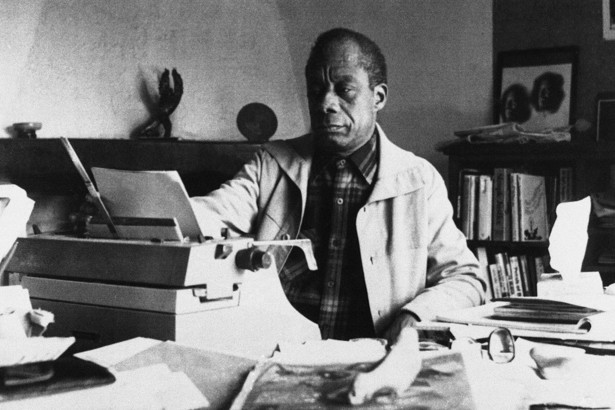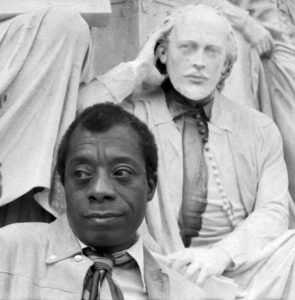
By Adam Marletta
Author, Chris Hedges, in a recent column for Truthdig, calls Raoul Peck’s Academy Award-nominated film about James Baldwin, I Am Not Your Negro, “one of the finest documentaries I have ever seen.”
“I would have stayed in the theater in New York to see the film again if the next showing had not been sold out,” writes Hedges.
Portland theater-goers interested in the documentary film are experiencing a similar problem. The film’s recently concluded run at the Portland Museum of Art proved so popular that additional showings had to be added in April to meet the demand.
Readers who want to see I Am Not Your Negro should definitely get tickets while they can. The film is, as the Washington Post’s Ann Hornaday writes, “a brilliant piece of filmic writing, one that bursts with fierce urgency…”
Though based on the notes, words, interviews, and writings of author and essayist, James Baldwin, Peck’s film is no mere biopic.
Instead, Peck has attempted something far more daring. I Am Not Your Negro envisions Baldwin’s final, incomplete work. The unfinished book — to be titled, Remember This House — was to be a comprehensive, personal account of Baldwin’s close relationship with the three key figures of the Civil Rights movement: Malcolm X, Medgar Evers, and Martin Luther King, Jr.
Baldwin died in 1987, having completed only 30 pages of the manuscript.
Using a combination of Baldwin’s own voice — supplied through audio recordings, television interviews, and archival footage — and that of actor, Samuel L. Jackson reading from Baldwin’s manuscript, Peck eschews the traditional “talking heads” format and allows his subject to tell the story of black America in his own words.
“The story of the Negro in America is the story of America – or, more precisely, it is the story of Americans,” Baldwin writes in his essay, “Many Thousands Gone,” collected in the 1955 compilation, Notes of a Native Son. “It is not a pretty story: the story of a people is never very pretty.”
But the film’s chilling coup de grace is achieved through its juxtaposition of contemporary images and video of victims of police violence including Freddie Gray, Michael Brown, Tamir Rice, and Sandra Bland. Clips from the mass protests in Baltimore and Ferguson, Missouri highlight the sickening reality that, in the 30 years since Baldwin’s death, precious little has fundamentally changed for black Americans.
The work of James Baldwin is undergoing something of a resurgence of late, and it is not difficult to see why.
In the wake of the increase in police killings of unarmed black men and women, greater scrutiny of the issue of mass incarceration prompted by Michelle Alexander’s best-selling, The New Jim Crow, the rise of a young, impassioned anti-racist movement in the guise of Black Lives Matter, and the election of an overt racist to the White House, leftists are seeking guidance and wisdom in Baldwin’s poetic prose.
Indeed, Baldwin is equal perhaps only to George Orwell in his prophetic vision, his command of the English language, and his unwavering commitment to telling inconvenient truths.
Baldwin’s novels, Go Tell It on the Mountain (1953) and Giovanni’s Room (1956), along with his searing essays, The Fire Next Time (1963), Notes of a Native Son (1955), and Nobody Knows My Name (1961) exposed, in prose that is both lyrical and uncompromising, the dark cancer of racism.
“If we were white, if we were Irish, if we were Jewish, if we were Poles … our heroes would be your heroes, too,” says Baldwin.
Nat Turner would be a hero instead of a threat. Malcolm X might still be alive… But when the Israelis pick up guns, or the Poles, or the Irish, or any white man in the world says “Give me liberty or give me death,” the entire white world applauds. But when a black man says exactly the same thing, word for word, he is judged a criminal, and treated like one, and everything possible is done to make an example of this bad nigger so there won’t be any more like him.
Baldwin’s novels also grappled with issues of homosexuality decades before the emergence of the gay rights movement. (Baldwin was gay, a fact often overshadowed by his civil rights advocacy.)
In every instance, Baldwin went out of his way to defy expectations and literary trends. He did not want to follow in the footsteps of other African American writers, like Richard Wright, whose work he was often critical of. And Baldwin refused to be pigeonholed as a writer of what he termed “protest novels.”
Baldwin brought this uncompromising stance to his activism, as well. Though Baldwin clearly adhered to liberal-left politics, he was reluctant to identify with any official political cause, party or movement.
As a result, James Baldwin — not unlike, again, Orwell — positioned himself more as a reporter or chronicler of the Civil Rights movement, rather than an active participant in it.

Baldwin with Shakespeare by Allan Warren – Own work, CC BY-SA 3.0
The film opens with Baldwin’s 1957 return to America after living abroad in France for nearly a decade. Baldwin wearily confesses that he never really missed America while he was away, nor the stereotypical staples of American culture like hot-dogs, baseball, and New York City. But the images of 15-year-old, Dorothy Counts, as she is bullied and harassed by white students in a newly desegregated high school in Charlotte, North Carolina, prompted Baldwin to return to the States.
“I could simply no longer sit around Paris discussing the Algerian and the black American problem,” says Baldwin. “Everybody was paying their dues, and it was time I went home and paid mine.”
“If you have not read Baldwin you probably do not fully understand America,” Hedges writes in his piece. “Especially now.”
To understand America is to acknowledge the uncomfortable, horrifying truth so many of us are afraid to admit: This nation was founded on mass genocide and slavery. It is to concede the painful truth that America fought a bloody civil war, not to defend so-called “states’ rights,” as so many of us are taught in school, but to maintain the institution of slavery.
And it is to understand, as Karl Marx did, that both the institution of slavery and the malignant disease of racism that continues to plague America some 150 years after slavery was abolished, are integral components of capitalism. Capitalists cynically employ racial animosity – alongside the equally deplorable oppression of sexism, xenophobia, homophobia, and ableism – to sow fear and distrust among members of the working class.
The goal is to keep workers so busy fighting among themselves they fail to unite against their mutual oppressor: the bourgeoisie.
As the great abolitionist, Frederick Douglass put it, the ruling class in pitting white workers against black workers, “divided both to conquer each.”
The solution, then, is not to agonize over our individual “privilege,” or to reduce the role of white anti-racists to that of mere “allies.” Rather, we must develop a multi-racial, multi-gender, multi-ethnic mass movement that can fight for nothing less than the self-emancipation of the working class.
By the closing credits – punctuated by Kendrick Lamar’s excoriating, “The Blacker the Berry” – I felt simultaneously galvanized by Baldwin’s words, but discouraged that some 30 years after his death, white Americans have largely failed to heed his prophetic words.
“The question you got to ask yourself … the white population of this country’s got to ask itself,” Baldwin says on an archival clip from an interview on Boston Public Television, “is why it was necessary to have a nigger in the first place. Because I’m not a nigger. I’m a man.”
“But if you think I’m a nigger, it means you need it, and you have got to find out why. And the future of the country depends on that.”





The Fire This Time – A Look at the James Baldwin Biopic
By Adam Marletta
Author, Chris Hedges, in a recent column for Truthdig, calls Raoul Peck’s Academy Award-nominated film about James Baldwin, I Am Not Your Negro, “one of the finest documentaries I have ever seen.”
“I would have stayed in the theater in New York to see the film again if the next showing had not been sold out,” writes Hedges.
Portland theater-goers interested in the documentary film are experiencing a similar problem. The film’s recently concluded run at the Portland Museum of Art proved so popular that additional showings had to be added in April to meet the demand.
Readers who want to see I Am Not Your Negro should definitely get tickets while they can. The film is, as the Washington Post’s Ann Hornaday writes, “a brilliant piece of filmic writing, one that bursts with fierce urgency…”
Though based on the notes, words, interviews, and writings of author and essayist, James Baldwin, Peck’s film is no mere biopic.
Instead, Peck has attempted something far more daring. I Am Not Your Negro envisions Baldwin’s final, incomplete work. The unfinished book — to be titled, Remember This House — was to be a comprehensive, personal account of Baldwin’s close relationship with the three key figures of the Civil Rights movement: Malcolm X, Medgar Evers, and Martin Luther King, Jr.
Baldwin died in 1987, having completed only 30 pages of the manuscript.
Using a combination of Baldwin’s own voice — supplied through audio recordings, television interviews, and archival footage — and that of actor, Samuel L. Jackson reading from Baldwin’s manuscript, Peck eschews the traditional “talking heads” format and allows his subject to tell the story of black America in his own words.
“The story of the Negro in America is the story of America – or, more precisely, it is the story of Americans,” Baldwin writes in his essay, “Many Thousands Gone,” collected in the 1955 compilation, Notes of a Native Son. “It is not a pretty story: the story of a people is never very pretty.”
But the film’s chilling coup de grace is achieved through its juxtaposition of contemporary images and video of victims of police violence including Freddie Gray, Michael Brown, Tamir Rice, and Sandra Bland. Clips from the mass protests in Baltimore and Ferguson, Missouri highlight the sickening reality that, in the 30 years since Baldwin’s death, precious little has fundamentally changed for black Americans.
The work of James Baldwin is undergoing something of a resurgence of late, and it is not difficult to see why.
In the wake of the increase in police killings of unarmed black men and women, greater scrutiny of the issue of mass incarceration prompted by Michelle Alexander’s best-selling, The New Jim Crow, the rise of a young, impassioned anti-racist movement in the guise of Black Lives Matter, and the election of an overt racist to the White House, leftists are seeking guidance and wisdom in Baldwin’s poetic prose.
Indeed, Baldwin is equal perhaps only to George Orwell in his prophetic vision, his command of the English language, and his unwavering commitment to telling inconvenient truths.
Baldwin’s novels, Go Tell It on the Mountain (1953) and Giovanni’s Room (1956), along with his searing essays, The Fire Next Time (1963), Notes of a Native Son (1955), and Nobody Knows My Name (1961) exposed, in prose that is both lyrical and uncompromising, the dark cancer of racism.
“If we were white, if we were Irish, if we were Jewish, if we were Poles … our heroes would be your heroes, too,” says Baldwin.
Baldwin’s novels also grappled with issues of homosexuality decades before the emergence of the gay rights movement. (Baldwin was gay, a fact often overshadowed by his civil rights advocacy.)
In every instance, Baldwin went out of his way to defy expectations and literary trends. He did not want to follow in the footsteps of other African American writers, like Richard Wright, whose work he was often critical of. And Baldwin refused to be pigeonholed as a writer of what he termed “protest novels.”
Baldwin brought this uncompromising stance to his activism, as well. Though Baldwin clearly adhered to liberal-left politics, he was reluctant to identify with any official political cause, party or movement.
As a result, James Baldwin — not unlike, again, Orwell — positioned himself more as a reporter or chronicler of the Civil Rights movement, rather than an active participant in it.
Baldwin with Shakespeare by Allan Warren – Own work, CC BY-SA 3.0
The film opens with Baldwin’s 1957 return to America after living abroad in France for nearly a decade. Baldwin wearily confesses that he never really missed America while he was away, nor the stereotypical staples of American culture like hot-dogs, baseball, and New York City. But the images of 15-year-old, Dorothy Counts, as she is bullied and harassed by white students in a newly desegregated high school in Charlotte, North Carolina, prompted Baldwin to return to the States.
“I could simply no longer sit around Paris discussing the Algerian and the black American problem,” says Baldwin. “Everybody was paying their dues, and it was time I went home and paid mine.”
“If you have not read Baldwin you probably do not fully understand America,” Hedges writes in his piece. “Especially now.”
To understand America is to acknowledge the uncomfortable, horrifying truth so many of us are afraid to admit: This nation was founded on mass genocide and slavery. It is to concede the painful truth that America fought a bloody civil war, not to defend so-called “states’ rights,” as so many of us are taught in school, but to maintain the institution of slavery.
And it is to understand, as Karl Marx did, that both the institution of slavery and the malignant disease of racism that continues to plague America some 150 years after slavery was abolished, are integral components of capitalism. Capitalists cynically employ racial animosity – alongside the equally deplorable oppression of sexism, xenophobia, homophobia, and ableism – to sow fear and distrust among members of the working class.
The goal is to keep workers so busy fighting among themselves they fail to unite against their mutual oppressor: the bourgeoisie.
As the great abolitionist, Frederick Douglass put it, the ruling class in pitting white workers against black workers, “divided both to conquer each.”
The solution, then, is not to agonize over our individual “privilege,” or to reduce the role of white anti-racists to that of mere “allies.” Rather, we must develop a multi-racial, multi-gender, multi-ethnic mass movement that can fight for nothing less than the self-emancipation of the working class.
By the closing credits – punctuated by Kendrick Lamar’s excoriating, “The Blacker the Berry” – I felt simultaneously galvanized by Baldwin’s words, but discouraged that some 30 years after his death, white Americans have largely failed to heed his prophetic words.
“The question you got to ask yourself … the white population of this country’s got to ask itself,” Baldwin says on an archival clip from an interview on Boston Public Television, “is why it was necessary to have a nigger in the first place. Because I’m not a nigger. I’m a man.”
“But if you think I’m a nigger, it means you need it, and you have got to find out why. And the future of the country depends on that.”